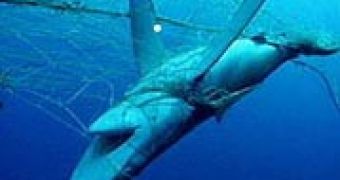Sharks are extremely sensitive to electric fields, and this enables them to detect their preys, as all living creatures emit weak electric fields. But this ability of the sharks comes with pros and cons: in captivity, sharks avoid metals reacting with seawater and producing an electric field. In fact, this may be their salvation, as metal longline gears could decrease the number of bycatch of sharks. A new research made at NOAA and presented at April's NOAA-sponsored shark deterrent workshop in Boston revealed that the behavior of captive juvenile sandbar sharks was impaired by the presence of an electropositive alloy, palladium neodymium. The alloy changed the swimming patterns of sharks and temporarily stopped their eating behavior.
Shark bycatch is one of the main causes of the current collapse in number of many shark species, as sharks compete with target species (like tuna) for baited lines. 11 to 13 million sharks represent world's annual bycatch each year, surpassing even the targeted fish species in some cases. The sharks also decrease the valuable fish catch while boosting operating costs.
Rare metals had been found to stop spiny dogfish (a small shark) from attacking baits. Electropositive alloys could be even more effective, as their generated electric fields are even more powerful.
"Individual sandbar sharks would generally not approach the metal ingots closer than about 24 in (60 cm), nor attack pieces of cut bait suspended within approximately 12 in (30 cm). This study clearly shows the alloy has the potential to repel sharks from pelagic longline fishing gear so they are not caught as bycatch, but the optimal size and shape of the alloy and other factors needs to be determined," said Richard Brill, a research scientist at NOAA's Northeast Fisheries Science Center and head of the Cooperative Marine Education and Research (CMER) Program at the Virginia Institute of Marine Science.
So far, shark repelling electronic devices have been too big and useless for their employment on longline fishing gear. The new study investigated small ingots of a relatively inexpensive alloy. The next step is to check how the alloy works in nature.
"Juvenile sandbar sharks (up to 5-year old) were used in the study because they are readily available in the estuaries along Virginia's coast, do well in captivity, feed easily, and their constant forward motion makes it easy to measure changes in their swimming patterns. They are good models for the species of sharks that are a significant problem in pelagic or open ocean longline fisheries worldwide," said Brill.
Sharks have slow growth and sexual maturation, and that's why shark populations do not present high rates of mortality and recover extremely slowly. The decrease of their populations could change marine ecosystems significantly.
"The alloy we used, palladium neodymium, appears to be a good alternative to more expensive metals. It is also machinable and is reasonably resistant to corrosion in seawater. How long the metal will last before corroding and how long it will repel sharks in the field, however, needs to be determined," said Brill.

 14 DAY TRIAL //
14 DAY TRIAL //